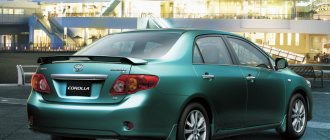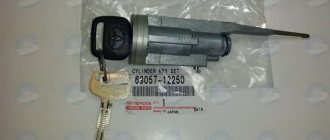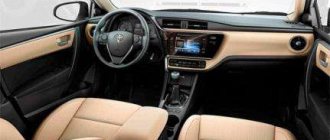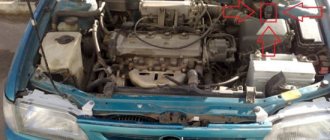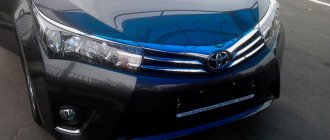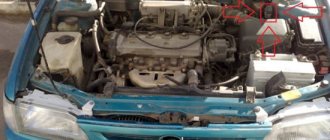In terms of noise insulation, the Toyota Corolla is practically not inferior to its competitors in the C-class, and even surpasses some. This time the manufacturer did not ignore the problem areas of the car - arches, floor, trunk, niche for the spare wheel and the interior ceiling, but did it, as always, in its own economical way. Insufficient sound insulation and creaking interior parts are increasingly prompting car owners to retrofit them.
Task: soundproofing a Toyota Corolla in the “Gold” configuration
The main requirement of the customer was: “To make complete and high-quality sound insulation of the car.” A balanced and justified approach is not to waste time on “half measures”, and if you really take it, then take it seriously. Today we have to:
· Remove the inner plastic trim.
· Remove factory sound insulation.
· Install high-quality insulating materials.
· Carefully place the trim in place.
Two craftsmen will work on the car. The total estimated operating time is 14 hours.
Solution: installation of sound insulation for a Toyota Corolla car in the “Gold” configuration
To implement our plans we will need: a high quality vibration damper; no less high-quality soundproofing non-woven material; fine-pored “acoustic” coating and modern car felt. The combination of a vibration damper (4 mm) and a sound insulator (8 mm) on the floor and in the trunk, an additional acoustic layer under the door panels and vibration protection for the hood will help eliminate 70% of the noise in the car interior.
What material did I choose for sound insulation?
In my work I used STP material for a number of reasons:
- 1. For sound insulation, well-known manufacturers should be used, not only responsible for the quality of the products, but also ready to offer a wide selection of materials.
- 2. The manufacturer must have new products: time moves forward and technology does not stand still.
- 3. Reviews should not be negative (I exclude any flood, for example: Guerlain is better than Bimast Bomb because it is heavier and cheaper... - without substantiated evidence this is “garbage”).
PS : I hesitated between two well-known manufacturers STP and SGM Technologies, but chose the first because of the new Aero (vibration isolation).
There is vibration and noise insulation for various areas of the car - for doors, for example, vibration insulation - M2, many studios currently use the more advanced material Vibroplast Gold, but I chose the new STP Aero.
Why chose Aero
A. The revolutionary breakthrough in StP Aero is that this material works almost all year round. ILC is measured at 20 C, and in this range there are undisputed leaders (the same Bomb). But in reality (we are in Russia), our temperature throughout the year is several times lower. Hence the need for a new approach, new material. StP Aero is just such a material - its LMF at low temperatures is higher than that of its analogues (Golda, Silver, and all other 2-3 mm materials that are on the market).
B. In addition, 1 sheet. StP Aero is 0.5 kg lighter than StP Gold (in my case, the door becomes 1.5 kg lighter than if I had used Gold)!
C. During installation, I discovered another big plus of Aero - at an air temperature of +25-26°C, sheets laid out in direct sunlight heat up to about 50°C quite quickly (the foil of the top layer is black) and USE A HAIRDRYER NOT Practical!
On the first weekend, on Saturday morning, having gone and purchased the material, I immediately went to the garage to soundproof the doors.
Procedure for soundproofing
Outdoors +26°C - laid out vibration insulation sheets in the sun,
While they were warming up, I began to prepare the workplace and laid out the tools for work: flat-head and Phillips screwdrivers, a 10-head wrench, a stitching roller, a tape measure, a backing for cutting/fitting sheets (cardboard), a marker, a hair dryer (in warm weather, a hair dryer is not needed! ), water, soap, degreaser.
1. I removed the door trim (2 bolts and pistons), removed the PET film from the inside of the door (factory protection against moisture), washed the inside of the place where the vibration insulation was glued with water and soap, then degreased all the washed surfaces inside the door and the outer part of the inner door .
2. The vibration isolation sheets have already warmed up (your fingers can barely tolerate the touch of the Aero sheet heated in the sun).
Using a tape measure, I took measurements inside the door on the outside - from the stiffening rib to the rib below (this is the height) and along the length.
I got the following: inside the door, the outer side is divided into 3 sectors, these sectors have the form of an unequal trapezoid (if you look from the lock to the hinge, the lock has a greater height), the middle part from the stiffener to the pipe has the same type of geometry, and the lower part (from the stiffening pipe down, not reaching the bottom 2-3 cm, so as not to close the drain holes in the door) has the opposite geometric shape.
3. I cut off the measured pieces of vibration isolation, tried it on inside the door (without removing the protective paper film) - the main thing is that the vibration isolation should lie directly on the door wall, and not on the amplifiers, because further rolling the Shumka onto the metal of the amplifier will only be a waste of material.
4. After adjusting the workpieces, I removed the protective paper film on the bitumen part of the Aero, carefully glued it (as soon as you apply a vibration to the prepared metal, it firmly sticks to it) and rolled the workpiece to the inside of the outer sheet of the door with a rolling roller.
Thus, the air between the metal surface and the vibration insulation is thoroughly removed.
Any STP vibration isolation has “scales” - so the vibration isolation is considered to be of high quality when, after rolling with a roller (or something similar), there are no “scales” on the foil surface (in this case, the vibration isolation will work 100%).
The maximum efficiency from gluing with STP Aero vibration insulation is achieved when processing 70-80% of the total area of the treated surface (in my version, 20-30% - these are the stiffening ribs on the surface of the door, which I did not glue).
Let's proceed to the outside of the inside of the door: The main task is to close the internal cavities, while creating an internal closed volume for high-quality acoustic sound.
Since in the future I still plan to change the standard acoustics to component ones, I decided to stick a layer of sound insulation from STP BiPlast 10K only on the rear door trims (there are no speakers there).
After I install component acoustics in the front doors, they will also be modified with STP BiPlast 10K sound insulation.
After vibration isolation of the doors, pieces of STP Aero remain - I used them to glue the door trim in places (this will prevent the plastic trim from resonating), and on top is the same STP BiPlast 10K.
Since the standard felt was not removed from the skins, it turned out like this:
I assembled everything: I inserted the handle cables into the grooves of this handle, connected the window lift cable, inserted the trim opposite the fastening grooves on the door and from top to bottom, we began to snap all the pistons into place.
On the rear doors, everything is similar, only to install the handle of the manual window lifter, we attach the bracket/clamp into the grooves of the plastic handle and, pressing on the already assembled trim, recessing the handle with the attached bracket deep into the axis of the window lifter, we snap the handle.
Where is additional sound insulation installed?
- Installing Shumka on a Corolla in a specialized auto repair shop.
- An option to do such work yourself.
Both cases have their pros and cons.
Advantages when visiting a service station:
- We get quality work done.
- Installation time is spent less.
Disadvantages when visiting a service station:
- The price needs to be discussed separately.
Installing sound insulation with your own hands gives:
- Significant savings of your money.
Possible disadvantages include:
- Extended deadlines for completing work.
- The quality of the Shumka's installation is lower.
- It is possible that when assembling a Toyota car, “extra” parts may remain.
There is something common in the development of events. When contacting a service station, the customer may refuse to install sound insulation on certain areas of the car. There is a generally accepted opinion: it is best to soundproof a car completely, not partially. This approach will eliminate the possibility of finding certain areas of the car through which extraneous noise will still penetrate. Judge for yourself: if you ignore the installation of noise insulation on the hood of a Toyota car, the sounds of a working power unit will continue to penetrate into the cabin. Additional protection of the car interior from extraneous noise will not help here!
